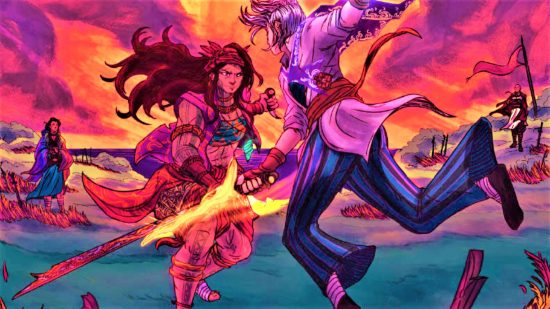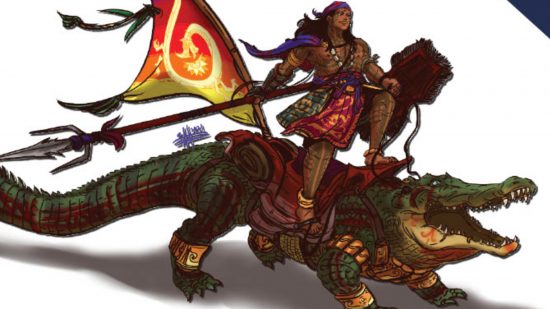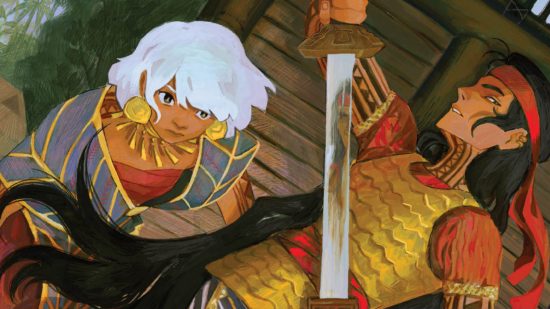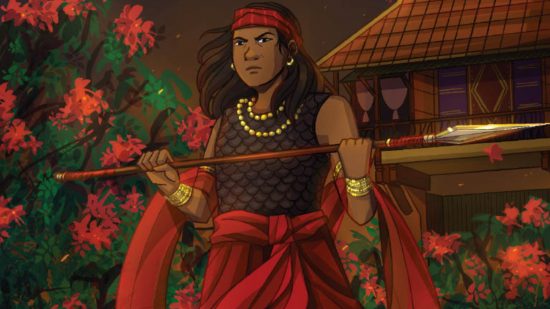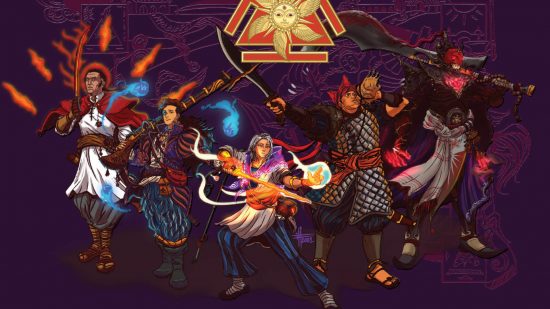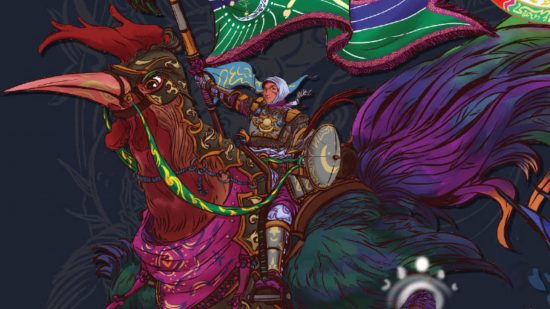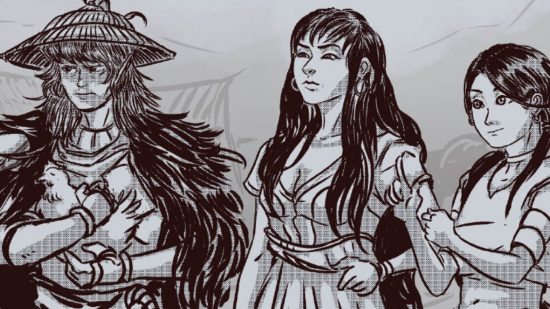Gubat Banwa is an incredible love letter to Southeast Asia, set in a fantasy version of that region. The game also uses combat inspired by the martial arts native to the area. Through violence and spirituality, the players, known as Kadungganan (meaning ‘honor’), shape the faith of the world. All of this stands on the shoulders of centuries of Southeast Asian history, which inspires the game’s unique setting.
Tabletop RPGs are for anyone, and games like Gubat Banwa are proof of that. Whether you’re a tabletop veteran who remembers when there were human-eldar hybrids in Warhammer 40k or a fresh-faced newbie who hasn’t stepped beyond D&D 5e, you can find a table that will welcome you with open arms.
However, when it comes to the games themselves, they haven’t always represented everyone. I don’t mean that literally – far be it from me to feel represented DnD Gnomes. I mean in the cultural sense. It’s undeniable that many of the most famous tabletop games right now were created with a Western audience in mind.
That’s what makes Gubat Banwa stand out.
It was not created from an outsider’s perspective like so many games set in non-Western settings. This was a Southeast Asian game created by Southeast Asians, which lends a beautiful authenticity to the setting. I had to know more about the game. With that in mind, I had an interview with JK ‘Waks’ Saavedra, Gubat Banwa’s creator, as well as Dylan ‘Dyl’ Briones, the game’s lead artist.
“I don’t think I can be in any particular huge authority if the games are completely diverse now but in my point of view, it’s still sort of ramping up to that,” says Saavedra on the state of diversity within the tabletop scene. “I know a lot of people personally that want to do all these other unique, weird things with their RPGs. It’s just that it’s kind of hard to have a foot in the door, so to speak, but I think things are kind of getting easier”.
Diversity and inclusivity are tricky topics to tackle in the tabletop scene. Truth be told, the problems surrounding them usually aren’t a result of any malice towards other groups. It was a simple lack of exposure. With the onset of the internet, this problem slowly but surely started to fade.
The internet has made it possible for all kinds of tabletop fans to start interacting with each other, and find games that weren’t the typical ‘fantasy’. It’s no secret that Euro-American-centric stories such as Lord of the Rings, Conan the Barbarian, and The Grey Mouser inspired many of the most iconic tabletop RPGs. When tabletop settings turned their attention to Asia, however, it was usually from an outsider’s perspective. Rarely did it dig deeper than the flashiness of mystic martial arts.
“The mysterious and exotic Orient, land of spices and warlords, has, at last, opened her gates to the West.” So said the opening blurb for the 1985 Dungeons and Dragons supplement Oriental Adventures. Orientalism, the reduction of Asian culture to a series of easily identifiable stereotypes, was an unfortunate part of tabletop gaming’s history. Even if it didn’t come from a place of malice, it was certainly from a place of ignorance.
As a Filipino tabletop player, I never really felt an active ‘need’ to be represented when I was younger. After all, in Dungeons and Dragons, I could be whoever I wanted to be. Still, there was this strange feeling of wanting more from my fantasy worlds. I certainly wasn’t going to find it in Oriental Adventures. If anything, that just made me feel even more like an outcast.
When I stumbled upon Gubat Banwa though, it was different. The characters, the setting, and even the gameplay felt so familiar to me, and I hadn’t even played the game yet. Never has a tabletop game made me go “Whoa, I recognize that from Filipino history class” or “My grandma told me a story like this once” like Gubat Banwa has. There’s just something heartwarming about a game that hits so close to home.
“I was just really writing about Southeast Asia because it’s who I am”, says Saavedra. “It’s where I come from. The fact that a lot of people, at least in the West, see it as this new-ish perspective being shared is good.” That Southeast Asian perspective is immediately felt from the moment the game starts.
Gubat Banwa revels in its unique brand of cultural violence. It is abstract and kinetic, mirroring the flow of Eastern martial arts. Every attack is a barrage, every block a perfect parry, reflecting the dance-like flow of the martial arts itself. The Rhythm, thundering gongs that play during Gubat Banwa’s combat, resonates through each player. That same vibe is represented through the game’s distinctly Southeast Asian art style.
Gubat Banwa’s combat has its roots in an unorthodox version of Dungeons and Dragons 4e and Wuxia films. The tactical depth of the game didn’t run counter to its narrative weight. In fact, there were two game modes for this very purpose, War Drama, a game mode with a focus on narrative, and Tactical Martial Arts, which focuses on crunchy combat.
These epic fights are brilliantly portrayed through Briones’ artwork for Gubat Banwa.
“I think the biggest factor in my drawings for Gubat Banwa is that I’m a practicing Eskrima instructor,” says Briones. For the unfamiliar, Eskrima is an ancient weapons-oriented Filipino martial art. It has appeared in movies such as Game of Death (1978) and Dune (2021). “The ethos of that [Eskrima] has pretty much informed my work on Gubat Banwa as a whole in terms of what I want to portray. There was always a deliberate need to go against the grain of typical fantasy.”
The mechanics are only one way that Gubat Banwa honors Asian culture. There’s also the rich background lore that serves as the foundation for Gubat Banwa’s unique setting. These aren’t just taken from dusty old books or documentaries by amateur historians. These are real accounts from real people.
“We don’t develop disciplines strictly from a mechanical perspective”, says Saavedra. “We always think about the discipline within the context of its culture, within the context of its environment. We’re leaning into the fiction that we wanted to convey through the mechanics of the game”.
In the story of the Kadungganan, the player characters, a ragtag group of warriors and mystics, are heavily inspired by heroes of Filipino folklore. Some heroes would come from oral accounts of ancient tribal stories. Others were inspired by modern rumors that still persist in the provinces of the Philippines, such as the existence of actual aswang (Filipino equivalent to vampires) within secretive families.
Just like the developers behind iconic tabletop games such as Dungeons and Dragons or Warhammer, the creators channeled their own experiences into making Gubat Banwa. “This sense of wonder and awe, just looking at this world that is larger than me,” says Saavedra. “A lot of fantasy readers nowadays, they can’t get into it if they can’t understand it immediately. I think that’s inherently against the purpose of fantasy.”
And he’s right.
The unknown is an underrated aspect of modern fantasy. In the information age, it’s tempting to just search for answers immediately. For many tabletop games, finding resources is quite easy. Gubat Banwa is no exception, as it has a helpful community and plenty of resources. Even so, it remains a game of discovery.
Think of how it used to be back then for properties like Star Trek or Lord of the Rings. There was no internet for fans of the time to learn languages like Sindarin and Klingon. Instead, they had to learn those words through context and community.
There’s a sense of accomplishment in the endeavor, amplified by new knowledge. Only with Gubat Banwa, instead of a fictional species, it’s for real cultures that have gone underrepresented for far too long.
“I would share all these stories that I’ve been lucky enough to be told by Filipino martial arts masters”, says Briones. “There are a lot of these crazy stories inherited by us. I told Waks [Saavedra] we had to put them in.”
This authenticity plays a big part in Gubat Banwa’s storytelling. “I don’t want to use the shadows of something to inspire my work,” says Saavedra. “I want to use the origin of the shadows. I had to look at the source, and a lot of the media that inspired Gubat Banwa is directly from research into old Filipino folk stories.”
While authenticity is fantastic for both immersion and representation, it’s still a different culture. Presenting all these foreign ideas to a worldwide audience was bound to have its challenges. The issue with sticking to your roots is that not everybody is going to understand why you’re clinging so hard. “It’s good that it’s being shared but it also does show how limited perspectives can be when it comes to the fiction and the media that we ingest”, says Saavedra.
In a sort of roundabout way, Gubat Banwa is still the ‘mysterious East’ that D&D: Oriental Adventures was about. However, instead of something to be gawked at for its exotic qualities, it becomes a challenge.
You are no longer a tourist. You are an immigrant. Now you must learn all these new words, traditions, and dynamics to survive.
Gubat Banwa is committed to telling a story that’s firmly rooted in its setting. That boldness makes the project a testament to how diversity in the tabletop succeeds against all odds.
This is why creators such as Saavedra and Briones are important to the international tabletop scene. As Asians themselves, they understand that there’s far more to Asia than what the West was exposed to in outdated books and movies.
“We think we found a pretty good midpoint between accessibility and non-compromise which I’m particularly glad for,” says Saavedra. “It’s very refreshing to see people unfamiliar with our languages interact with them,” says Briones.
“Luckily enough, our community, they do try. I don’t see that happening a lot when it comes to Filipino media in general”. “Despite the challenges, that is a worthy goal”, Briones adds affectionately.
People all around the world fell in love with Gubat Banwa, just as I did, thanks to this blend of accessibility and authenticity. The same was true for its home, the Philippines. One of the things I’m most proud of about my country, despite its flaws, is its acceptance of ‘nerdy stuff’. Even as a kid, I never felt like an outcast for my hobbies.
“There really is no other direction for the community to go but up”, Saavedra says. “A lot of the new RPG people really enjoy games that aren’t just D&D here in the Philippines. They love diversity. They love the breadth of options. They love the games in general, right? They love the hobby.”
It didn’t really hit me just how cool it was that games like Gubat Banwa could exist until after the interview. This game which used aspects of my life, culture, and stories I grew up with, was being played by people all around the world. Not only that, they were made by fellow Filipinos living in the Philippines.
Now more than ever, there’s a place for people from all walks of life to enjoy the hobby. There’s a game where you could see not just yourself, but where you came from. A beautiful reflection of your own experiences, only much more fantastical than you could ever imagine.
For me, that game was Gubat Banwa.
For more deep dives into games, check out what publishers have to say about AI art in tabletop RPGs. Or, for more games based on diverse cultures, learn more about the political power of joy in D&D’s Journeys Through the Radiant Citadel.
All artwork used is courtesy of Gubat Banwa.
